|
|
The Blakely Burl Tree Project: The
Story
|
The Blakely Burl Tree Project
From The Ground Up
by Terry Martin |
WORKING IN THE STUDIO
Today Mark and Gary will start work on a piece
together. They have brought a large section of the tree from the mill to create
a sculpture that will not only express their collaborative vision, but also show
the potential of the rest of the tree. They also want to learn how the wood can
be worked, and how it behaves as it is cut and dries. It is work that will have
significant implications for the rest of the BBTP.
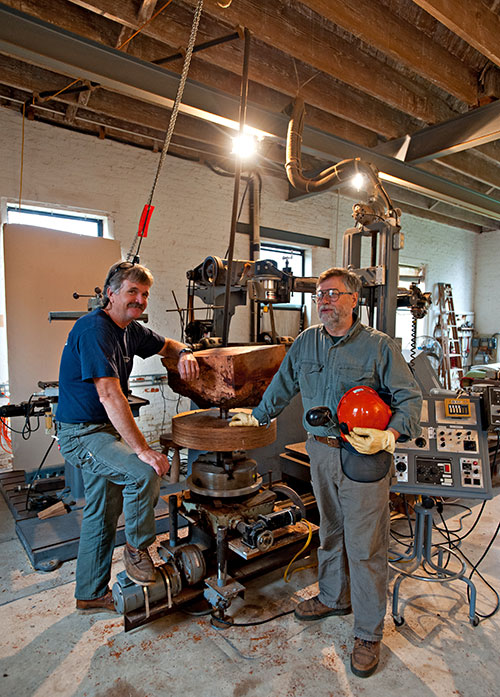
Gary Stevens (left) and Mark Lindquist begin work at Lindquist Studios,
Quincy Florida.
Photo: John McFadden
The piece of wood has been chosen for its interesting grain and it still has a
lot of bark attached. Mark and Gary agreed on this part of the tree because Mark
wants the art made for the museum to reflect the “treeness” of the project. In
other words, when people look at the art, they will not just be looking at
something made of wood, but at something that reflects the unique nature of the
Blakely Burl Tree. In future, when visitors to the museum see film and still
images of the tree before it was removed, they will be able to relate the art to
the site where it grew and where they are standing when they look at the art.
Mark and Gary want to create a sense of time and place, a creative connection to
all that happened in and around the Burl Tree right up to and including its
careful removal.
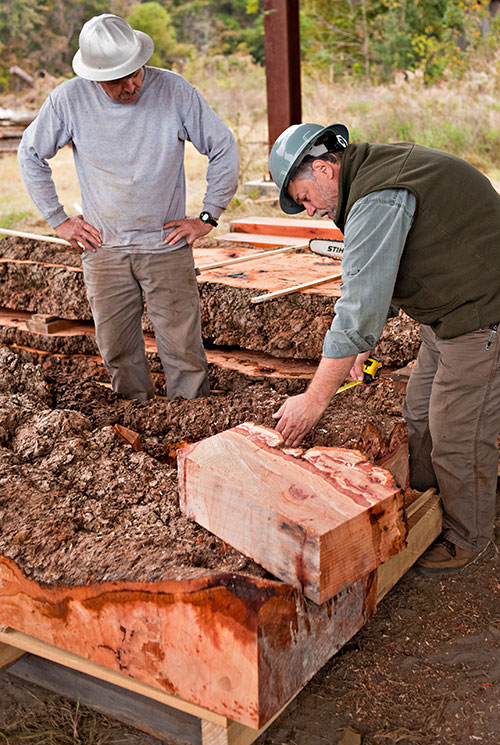
Mark Lindquist (right) and Gary Stevens choosing the wood for the first piece
they will make from the Blakely Burl Tree.
Photo: John McFadden
After so much time looking at the tree and agonizing about every cut, it’s time
for these two artists who know each other so well to perform their magic. It is
fascinating to watch how they relate to each other in this space that means so
much to them both. Clearly it is Mark’s domain that he has created over so many
years, but Gary has a history here too. He had already been working with wood
for more than twenty years, successfully selling his sculptural vessels, when he
met Mel and Mark. Gary came to Quincy to work as assistant to the Lindquists and
to learn as much as he could from them. Mel was already in his mid-80s and Gary
says, “We hit it off right off the bat. Mel was like a grandfather to me. When
we were working together in the studio he would use some old-time saying to
convey a thought or an idea. It would usually make me laugh and he’d smile and
nod his head. I cherish the time we got to spend together.”
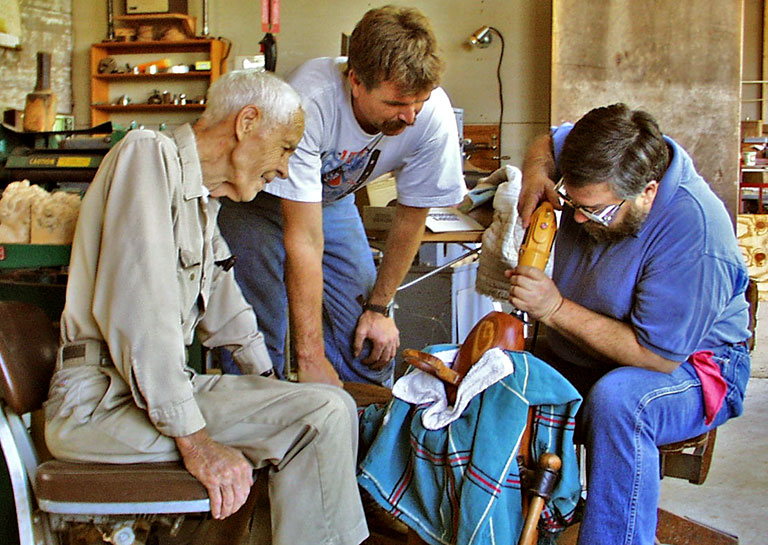
Mel Lindquist (left), Gary Stevens (center), Mark Lindquist (right) work on a
collaborative piece at Lindquist Studios, Quincy Florida, in 1998. Photo:
Kathy Lindquist
Mark also mentored Gary in many ways, as Gary explains: “Mark really worked with
me on sculpture. He made me go to the library and study artists like Jean Arp,
Max Bill, Brancusi and others. Then we’d have discussions about the artists and
their work. It really helped me focus on my sculptural forms and the direction
that I’ve taken.”
Mark worked with his father from the mid-1950s till Mel passed away in 2000 and
it is impossible to understand Mark’s life without including that influence.
Mark is always quick to acknowledge his father: “When I was young Mel taught me
everything I could imagine about being in the woods, about forestry and wood
lore, and about working with wood. Somehow we managed to get past the baggage of
being father and son, and we were able to traverse a special kind of
professionalism.”
As I look around me I see signs of Mel’s presence everywhere. His lathe and
tools stand where he left them, and even though he passed away nearly ten years
ago it is as if he just walked out yesterday, with his cap still hanging on a
nail where he left it. Now, as I watch these two friends manouver the large
piece of wood into the studio where they will carve it, I can almost see Mel
nodding in approval.
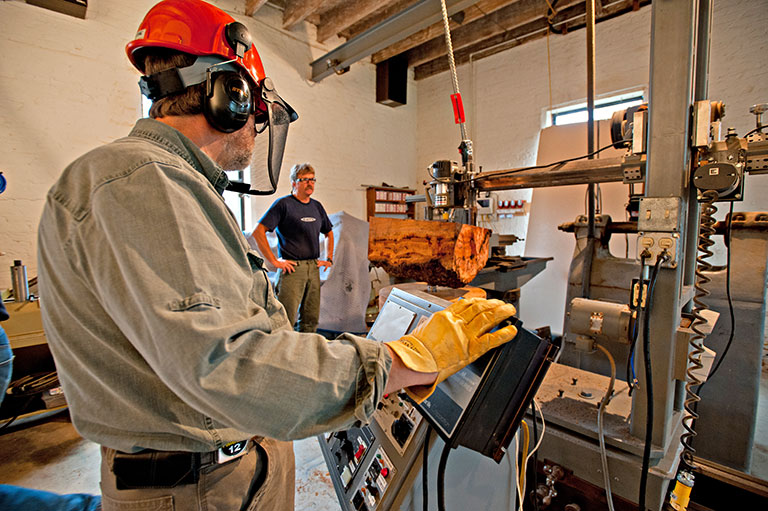
Mark Lindquist (foreground), begins milling the BBT wood as Gary Stevens
watches for defects.
Photo: John McFadden
Mark and Gary want some private time in the studio to begin work on their wood,
so I tell Mark that I’d like to make a piece from the wood Steve gave us to
thank him for his help in the project.

Ken Browne (left), Gary Stevens (center) and Mark Lindquist (right)
discussing the plans for moving ahead with the wood and filming the first piece
made at Lindquist Studios.
Photo: John McFadden
“Can I use a lathe to turn a bowl for Steve?” I ask.
“Sure,” said Mark. “Why don’t you use Mel’s lathe?”
He says it so casually that I think maybe I’ve misheard.
“Mel’s lathe?”
“Sure.”
“I didn’t think anybody uses that any more….”
“Well they don’t, but you can use it…and his tools too.”

Some of Mel Lindquist's tools - Lindquist Studios, Quincy, Florida.
Photo: John McFadden
That stops me in my tracks. Because I know how much Mel meant to Mark and how
the memory of his father hangs over everything Mark does, I’m deeply moved…and
worried! I’d better not mess this up.
I cut a section of the black persimmon and begin to turn a bowl. It is hard
going because the wood is still wet from being submerged. Now, after days of
watching Greg and Ken filming Mark and Gary, I find myself under the lens as
they record the making of this gift bowl.
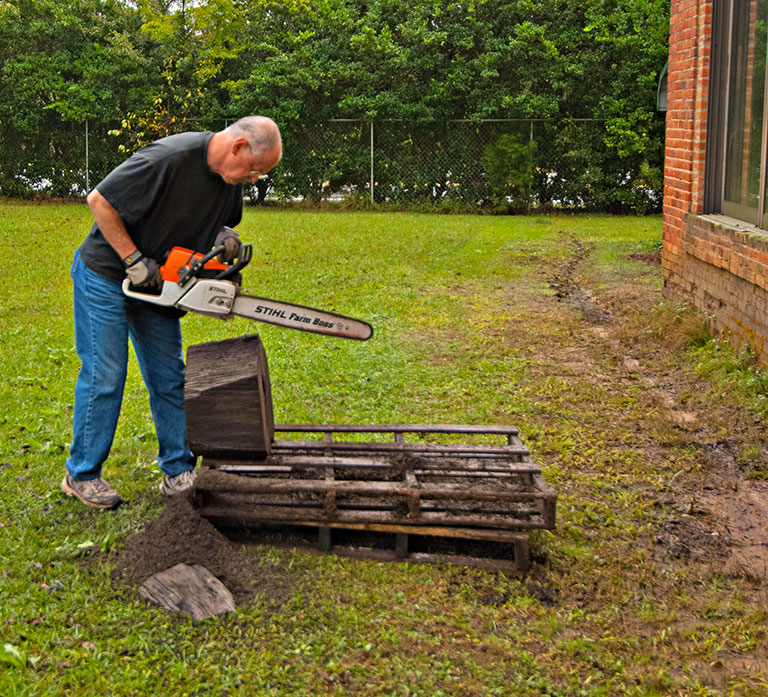
Terry Martin cutting the Black Persimmon given by Steve Cross.
Photo:
Mark Lindquist
I think, “OK, everyone is going to
look at this when I’m done. If I screw up it will be recorded in high
definition. And Mel’s looking over my shoulder to see if I mess up his lathe!” I
take a deep breath, determined to succeed with a piece of wood that should have
been left for a year to dry. Slowly, as I take ever finer cuts, the true nature
of the wood starts to show. It is a deep chocolate shade and when I have
finished turning it I use Mel’s buffing system to bring out the full depth of
the color. The piece will work. I breathe a deep sigh and hope that Steve and
his family will like the bowl.

Terry Martin turning Black Persimmon at Lindquist Studios. Photo:
John McFadden
John has been hovering while I work, the now-familiar shadow over my shoulder. I
know he has worked at Lindquist Studios for many years, so I ask him what it’s
like. “I grew up around lathes and saws and other mechanical things,” he says,
“so that side of Lindquist Studios feels normal to me. But then there’s the
other side. I revere any type of creative ability in people, so this place is
very special to me. I’ve been there when Mark is working on incredible pieces
and I’ve been able to help in that process and do a lot of photography as well.
I can’t wait to photograph Mark and Gary creating the first piece for the
Project. I feel very privileged to be here.”
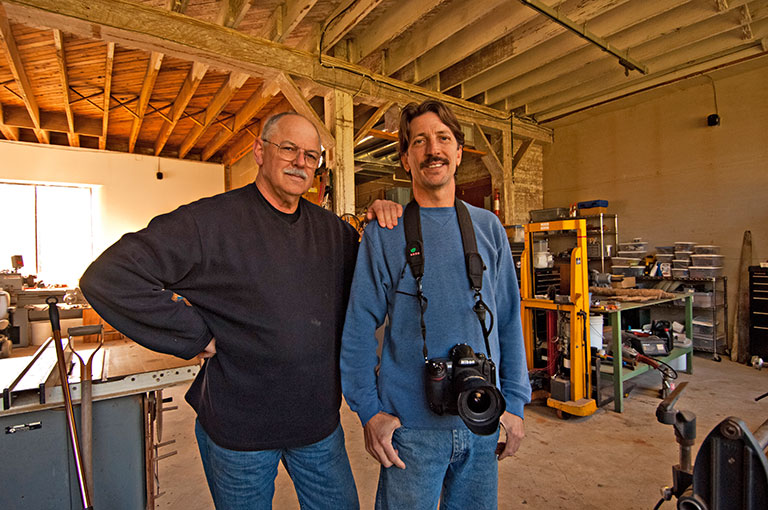
Studio Assistant and photographer John McFadden (right) and Terry Martin
(left) in the front studio during the project.
Photo:
Mark Lindquist
I ask him about working with Mark on the BBTP. “This Project is like a lot of
things that Mark has done in his life. He’ll go out on a limb for something that
he believes in, and he’ll follow that belief with determination and passion.
Sometimes it’s difficult to understand how involved everything can be and yet it
pretty much went according to the timeline Mark put together. That’s really a
testament to careful planning and to a lifetime of seeing the end from the
beginning. I’m always astonished at Mark’s understanding of what he wants to
accomplish. Through the years I’ve learned to trust that what he thinks needs to
happen is actually what does need to happen.”
Mark and Gary emerge from their seclusion to tell us they’ve started their
sculptural bowl, so we gather around the roughed-out piece.
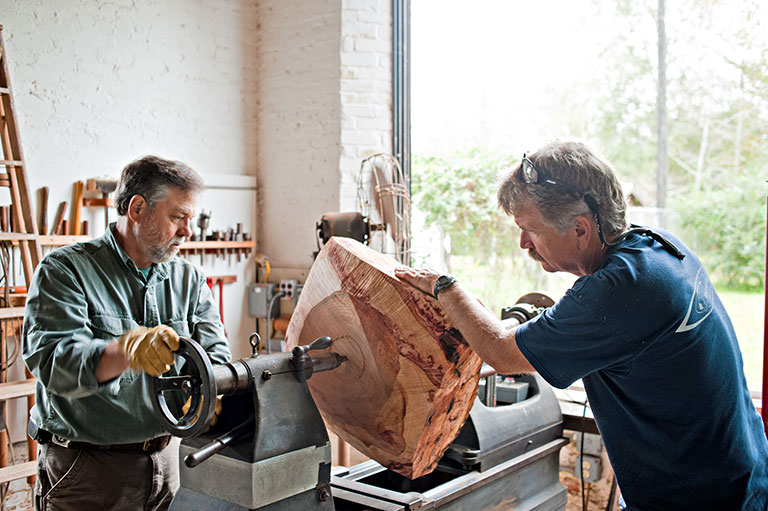
Mark Lindquist (left) and Gary Stevens mounting the first BBT block on
Lindquist's pattern maker's lathe.
Photo: John McFadden
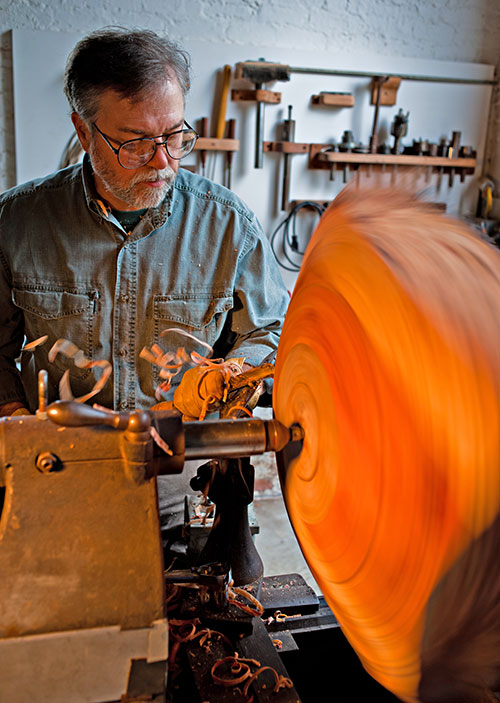
Mark Lindquist roughing out the sculpture on his lathe.
Photo: John McFadden
Mark has mounted it
on one of his robotic systems, a motor-driven chucking system that allows him to
move it to any position for carving.
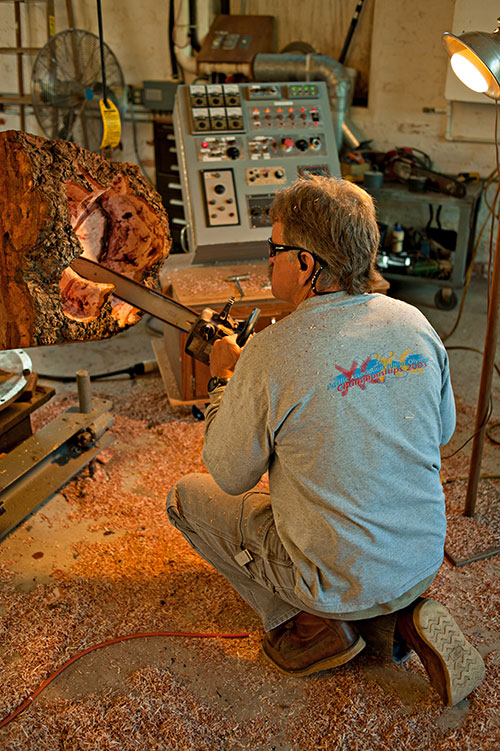
Gary Stevens roughing out the interior of the sculpture with his chainsaw.
Photo: John McFadden
They explain where they are heading with
the piece for the camera and then continue with the carving.
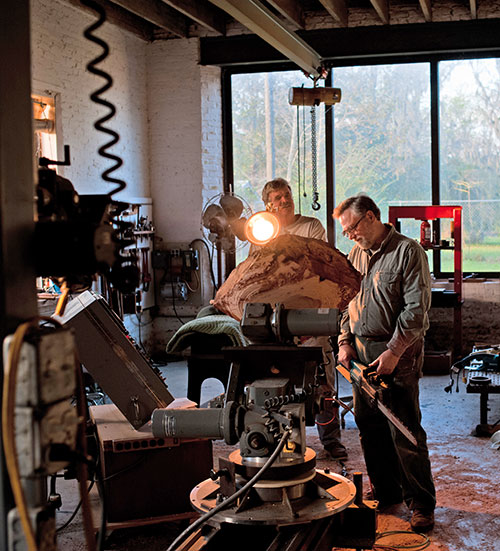
Mark Lindquist (right) and Gary Stevens, working on the sculpture. Photo:
John McFadden
Gary wields a small
chainsaw as a carving tool and the still-wet wood peels away under his sweeping
strokes. They pause to discuss what is being revealed.
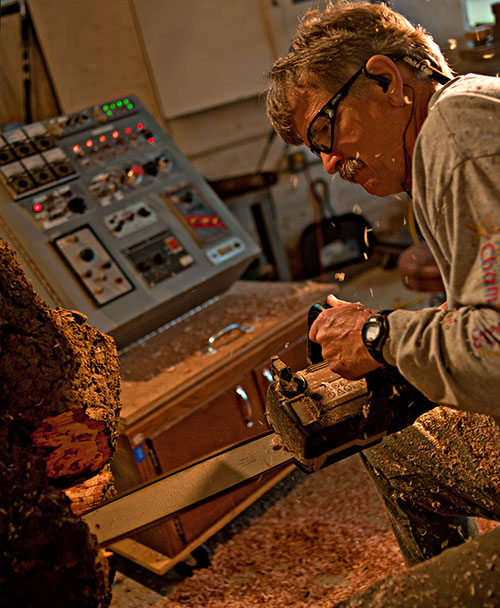
Gary Stevens continues interior carving. Photo:
John McFadden
“I think you can go here,” says Mark.
“You mean…?”
‘Let me show you.”
Mark takes over, and rounds off part of the wall of the vessel.
“Oh, I see,” says Gary.
They are making a vessel about two and a half feet across with bark retained all
around the rim. It is going to be deeply scalloped, which means the curves are
very complex. The contrast with all the days that Mark and Gary have been
cutting the tree is wonderful. From, “Maybe we’ll…” and “We might…”, there is a
new feeling of immediacy: “If I do this…see?” Every cut is an irrevocable step
in the process of creativity and I can see they are imbued with new energy. This
is the life of many wood artists—days or weeks of preparation, planning, and
visualizing, and then comes the payoff, the explosion of creativity. As their
piece slowly emerges it is a such a pleasure to watch Mark and Gary almost dance
around the wood.
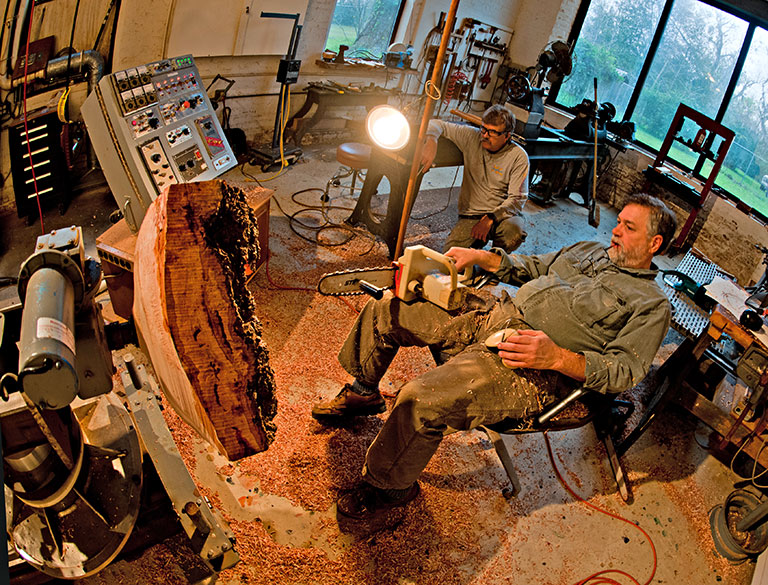
Mark Lindquist (right) and Gary Stevens discuss the direction of the piece,
taking a short break in their carving. Photo:
John McFadden
|
|